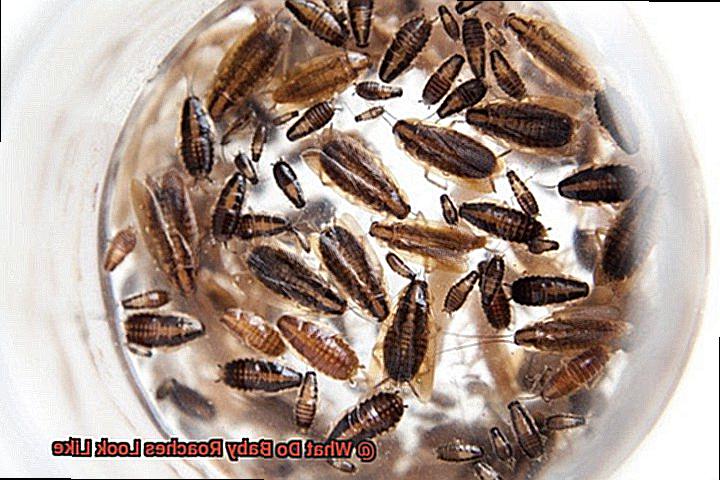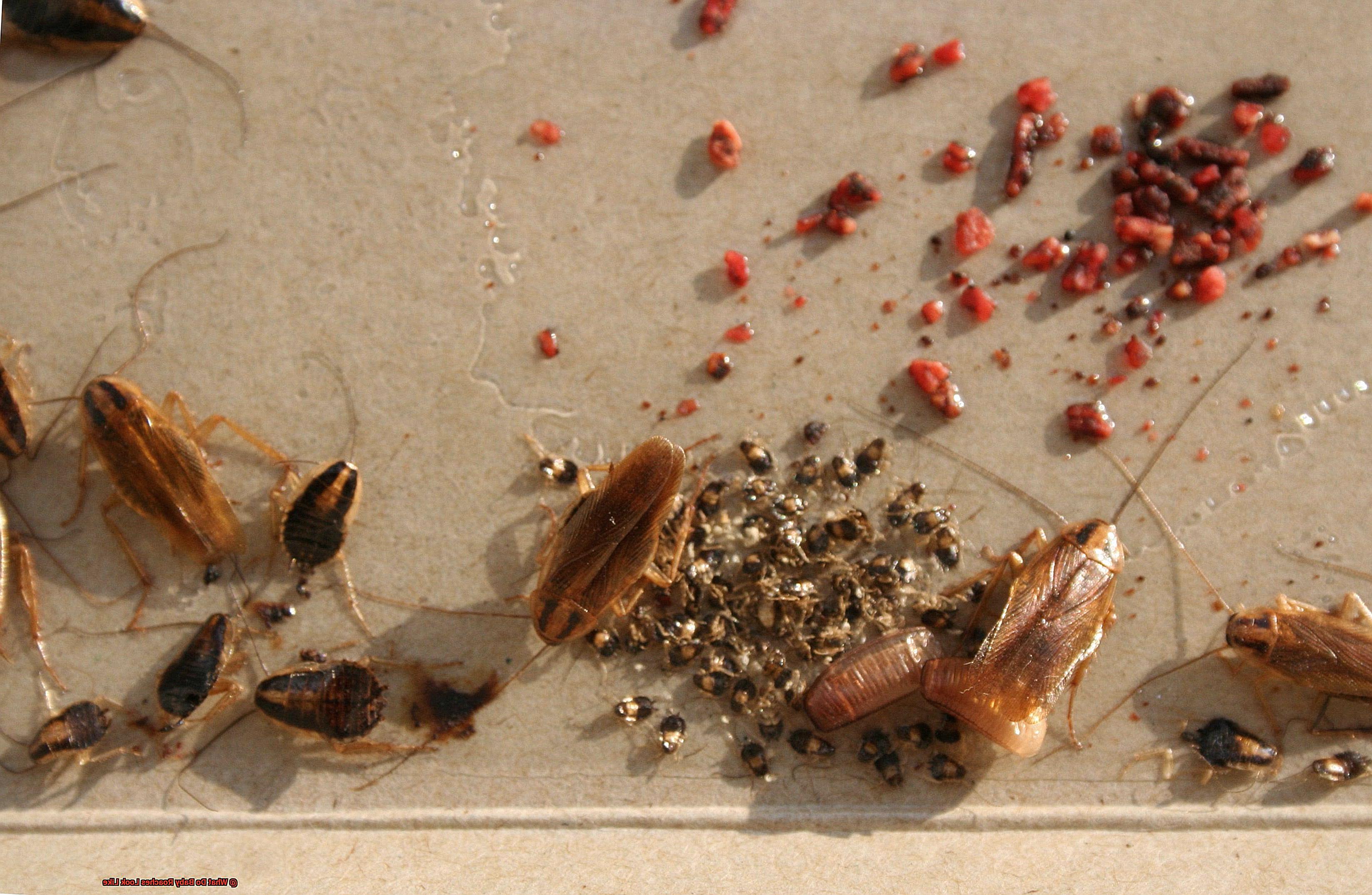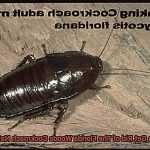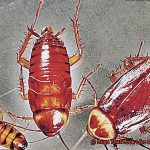Are you curious about what baby roaches look like? You might be surprised to know that identifying these tiny pests can actually help you prevent a full-blown infestation in your home. Roaches are notorious for their resilience, and their offspring, known as nymphs, are just as tough. By understanding what baby roaches look like, you can take the necessary steps to exterminate them before they become a bigger problem.
So, what do baby roaches look like exactly? Unlike adult roaches, nymphs are much smaller and don’t yet have wings. They’re typically the size of a grain of rice and have pale white bodies. As they mature, their exoskeleton will darken and harden until they eventually grow wings.
Identifying baby roaches is crucial because it often means there’s an infestation nearby. Roaches tend to hide during the day and come out at night, so if you spot a baby roach during daylight hours, it’s a clear sign that their hiding place has become overcrowded.

Don’t let these sneaky pests take over your home. Keep an eye out for any signs of baby roaches and take action early on to prevent a larger infestation. Trust us – it’s better to nip this problem in the bud before it becomes a nightmare down the road.
Types of Baby Roaches
Contents

If so, it’s possible that you may have a baby roach infestation on your hands. But fear not, we’re here to help you identify the different types of baby roaches that you may come across.
One common type of baby roach is the German cockroach nymph. These little critters are usually light brown in color and are less than a centimeter in length. They possess two dark stripes running down their backs and are frequently found in kitchens and bathrooms.
The American cockroach nymph, on the other hand, is larger than its German cousin, growing up to an inch in length. These reddish-brown-colored baby roaches have a yellowish margin on their thorax and can be found thriving in warm, moist areas such as basements, crawl spaces, and drains.
Another species of baby roach that you may encounter is the Oriental cockroach nymph. These tiny creatures are black or dark brown in color with a shiny appearance and grow up to an inch in length. They tend to make their homes in damp areas like basements and crawl spaces.
In addition to these three types of baby roaches, there are also the brown-banded cockroach nymph and the smokybrown cockroach nymph. Each species of baby roach has its own unique characteristics that can help you identify it.
It’s crucial to note that while baby roaches may be smaller than adult roaches, they can still cause significant problems if left untreated. Baby roaches can quickly grow into adult roaches and reproduce, leading to a worsening infestation. Therefore, it’s important to take swift action to eliminate all stages of cockroaches from your home or business.
In summary, identifying the various types of baby roaches is essential for effective pest control. Keep an eye out for these little creatures and act promptly if you notice any signs of an infestation.
Appearance of Baby Roaches
When it comes to identifying baby roaches, also known as nymphs, there are several distinct characteristics to keep in mind. Although they share some similarities with their adult counterparts, baby roaches have a unique appearance and behavior that sets them apart.
First and foremost, baby roaches are smaller in size than adult roaches and do not have wings. However, they do have small wing pads that will eventually develop into wings as they mature. They also tend to be lighter in color than adults and may have a translucent or milky appearance due to their underdeveloped exoskeleton.
But appearance isn’t the only thing that sets baby roaches apart from adults. They also exhibit different behavior, moving more quickly and appearing skittish or jittery. This is because they are still developing their coordination and reflexes.
It’s important to note that the appearance of baby roaches can vary depending on the species. For example, German cockroach nymphs are typically brown or tan with two dark stripes running down their backs, while American cockroach nymphs are reddish-brown with yellowish markings on their heads.
Identifying baby roaches is essential to preventing an infestation from taking hold in your home. By keeping an eye out for these pests and being aware of their unique appearance and behavior, you can take proactive measures to eliminate them before they become a larger problem.
German Cockroach Nymphs
As someone who’s knowledgeable about German cockroach nymphs, I can attest to the importance of keeping these pests out of your home. Although they may seem harmless at first, these tiny critters have the potential to wreak havoc on your living space in no time.
German cockroach nymphs are smaller in size than their adult counterparts and come in varying shades of light brown to almost black. They’re also identifiable by a distinctive stripe that runs down their backs. As they grow, these nymphs undergo several molts, shedding their exoskeleton each time to get bigger. You can spot these molts by the transparent exoskeleton left behind.
One of the most concerning things about German cockroach nymphs is their ability to reproduce quickly. A female German cockroach can produce up to six egg cases in her lifetime, each containing around 40 eggs. This means that if left unchecked, a single female German cockroach can give rise to over 200 offspring. That’s a lot of baby roaches running around.
To prevent a larger infestation from occurring, it’s vital to identify and eliminate German cockroach nymphs as soon as possible. Regular cleaning and sanitation can help remove potential food sources for these unwanted guests. But for more severe infestations, you may need professional pest control services to provide effective treatment options.
American Cockroach Nymphs
They may be smaller than their adult counterparts, but they share many of the same characteristics. These nymphs are typically around 1/8 to ½ inch in length and have a light brown color. They also have six legs, two antennae, and a pair of cerci located at the rear of their bodies. These cerci serve as a sort of radar system, helping the nymphs detect predators and navigate their environment.
As American cockroach nymphs grow, they shed their exoskeleton multiple times before reaching adulthood. During each molt, they develop a new exoskeleton and grow in size. Their color also changes from light brown to a darker reddish-brown. It’s amazing to witness this transformation take place.
These nymphs are more active than adult cockroaches and can move quickly to avoid danger. However, just like adult roaches, they can carry diseases and contaminate food and surfaces with germs and bacteria. It’s crucial to keep your home clean and free of potential food sources for roaches to prevent an infestation.
In conclusion, American cockroach nymphs are fascinating creatures that go through incredible transformations as they grow. By understanding their development and behavior, we can better protect our homes from these pesky pests. Regular cleaning and professional pest control services are essential for keeping roaches at bay.
Identifying Baby Roaches
But fear not – I’m here to guide you through the key characteristics to look out for.
Firstly, size matters. Baby roaches, or nymphs as they’re known in the biz, are significantly smaller than their adult counterparts, with a size range of 1/8 inch to 1/4 inch. So if you spot a little critter scuttling across your floor, take a closer look – it could very well be a baby roach.
Color is another important factor in identification. While adult roaches tend to be brown or black, baby roaches come in an array of hues – from white to light brown, and some even have stripes or spots on their bodies. This can make them harder to spot, but keep your eyes peeled for any unusual-looking insects lurking in your home.
The shape of baby roaches can also give them away. Nymphs have a more cylindrical shape than adults, with a smaller head and larger abdomen. Their wings are also underdeveloped, meaning they’re unable to fly or glide like their fully grown counterparts.
However, identifying baby roaches can be tricky as they can resemble other small insects such as beetles or crickets. If you suspect a baby roach infestation in your home, it’s best to contact a pest control professional for proper identification and treatment.
Signs of a Baby Roach Infestation
When it comes to identifying a baby roach infestation, it’s crucial to know what signs to look for. The first sign is the presence of egg casings or oothecae, which are small, brownish capsules that contain multiple roach eggs. These capsules are often found in hidden areas such as cracks or crevices and are a surefire sign that there is a growing population of baby roaches nearby.
But spotting actual nymphs or baby roaches themselves is another sign of an infestation. Though they can be difficult to distinguish from adult cockroaches, they are typically smaller in size and have a lighter coloration. They may also have less defined wings and antennae.
Another tell-tale sign is an unusual odor in the area where the infestation is located. Roaches produce a specific pheromone that can create a musty or oily smell in the air, particularly when there is a large number of roaches present.
In addition to these signs, you may notice small black or brown droppings around your home. These droppings are often found near food sources and can serve as a food source for baby roaches. And if you see any damage to paper products or materials around your home, this could be another sign of baby roach infestation. Roaches will often feed on paper and glue, leaving behind small holes or bite marks as evidence.
Steps to Take If You Find Baby Roaches
It’s possible that you have a baby roach infestation on your hands. Don’t fret – we’ve got you covered with these eight steps to take if you find baby roaches in your home.

Step one: Identify the species of roach. Different species require different methods of extermination, so it’s essential to know what you’re dealing with. Knowing the type of roach can help determine the best course of action for getting rid of them.

Step two: Eliminate their food sources. Roaches need food to survive, so keep your home clean and free of crumbs, spills, and other potential food sources. Regular cleaning can go a long way in preventing a roach infestation.
Step three: Seal up cracks and crevices. Roaches can squeeze through tiny openings in walls, floors, and ceilings, so seal up any gaps or holes. This will help prevent roaches from entering your home and laying eggs.
Step four: Use bait stations. These can be effective at attracting and killing roaches. Be sure to place them out of reach of pets and children to avoid any accidents.
Step five: Set traps. Sticky traps or glue boards can help catch roaches as they move around your home. Place them in areas where you’ve seen roaches or where there is a high likelihood of them appearing.
Step six: Vacuum regularly. Vacuuming can help remove any roaches or eggs hiding in carpets or other surfaces. Make sure to dispose of the vacuum bag outside immediately after use.
Step seven: Call in a professional exterminator. If your infestation is severe or if you’re not having success with DIY methods, it may be time to bring in the experts. A professional pest control company can help you get rid of the infestation quickly and efficiently.
Step eight: Take preventative measures. Once you’ve gotten rid of the baby roaches, it’s important to continue taking steps to prevent future infestations. Keep your home clean, seal up openings, and use deterrents like essential oils or diatomaceous earth.
By following these steps, you can effectively get rid of baby roaches and prevent a full-blown infestation from taking hold in your home.
Prevention Tips for Keeping Your Home Free from Baby Roaches
Don’t worry, preventing these pests from infesting your living space is easier than you might think. With a few simple tips, you can keep your home free from these unwelcome guests. Here are five prevention tips that you can follow to keep your home free from baby roaches:
Keep Your Home Clean
Roaches are attracted to dirty and cluttered spaces, so keeping a clean home is crucial in preventing infestations. Regularly clean floors, countertops, and cabinets, and avoid leaving dirty dishes in the sink overnight.
Seal All Cracks and Crevices
Roaches can enter your home through small cracks and crevices in your walls, floors or ceilings. Therefore, it’s essential to seal all openings with caulk or weather stripping to prevent them from entering.
Store Food Properly
Roaches are attracted to food sources; therefore, store all food in airtight containers to prevent baby roaches from accessing it. Make sure to clean up any spilled food or crumbs immediately.
Dispose of Garbage Properly
Roaches are also attracted to garbage, so it’s essential to dispose of garbage properly in sealed containers. Take out the trash regularly to avoid attracting baby roaches.
Eliminate Standing Water
Roaches thrive in moist environments, so make sure to fix any leaks and eliminate any standing water in your home.
Remember that prevention is always better than cure when it comes to pest control. These simple steps can help prevent a roach infestation from taking hold in your home. However, if you have a severe infestation or want an extra layer of protection, consider using pest control products such as baits, sprays, or traps.
TrWtUOWdbt8″ >
Conclusion
In summary, spotting baby roaches can be the key to stopping a full-blown infestation in your home. These little critters, also known as nymphs, are smaller than adult roaches and have yet to grow wings. They’re typically no bigger than a grain of rice and have pale white bodies that will darken and harden as they mature.
But why is identifying baby roaches so important? Well, it’s often a sign that there’s an infestation nearby. Roaches tend to hide during the day and come out at night, so if you spot a baby roach during daylight hours, it’s a clear indication that their hiding place has become overcrowded.
It’s worth noting that there are different types of baby roaches out there. From German cockroach nymphs to Oriental cockroach nymphs, each species has its own unique characteristics that can help you identify it.
Luckily, preventing these pests from taking over your living space is easier than you might think. Simple measures like keeping your home clean, sealing all cracks and crevices, storing food properly, disposing of garbage correctly and eliminating standing water can help keep roaches at bay.
Remember: prevention is always better than cure when it comes to pest control.






